Key Facts
- Michigan is home to 18 species of snakes. However, only one is venomous.
- The eastern massasauga rattlesnake in spite of being potentially dangerous is also reclusive.
- The pit viper prefers marshes, swamps, and wet prairies.
“The Great Lakes State” of Michigan is home to a variety of beautiful and interesting snake species. Snakes in Michigan are vital to keeping the ecosystems in balance, taking on the roles of both prey and predator. Of the 18 snake species in Michigan, only one is venomous: the eastern massasauga rattlesnake. Although this snake does have dangerous venom, it is extremely shy, secretive, and it is not aggressive. In fact, most residents of Michigan have never actually seen a massasauga in the wild. What does an eastern massasauga rattlesnake look like? Where does it live? How dangerous is it? Let’s take a closer look at Michigan’s only rattlesnake species.
Eastern Massasauga Rattlesnake

The Eastern Massasauga Rattlesnake has elliptical or vertical pupils that look like cat eyes.
©Ryan M. Bolton/Shutterstock.com
| Eastern Massasauga Rattlesnake | |
|---|---|
| Range | Lower Peninsula in Michigan |
| Length | 18-30 inches |
The eastern massasauga rattlesnake was once common throughout nearly every county of Michigan’s Lower Peninsula and on Bois Blanc Island. However, this snake has suffered a great deal from habitat loss and fragmentation, as well as indiscriminate killing and persecution from humans. In the past 10 years the population of eastern massasauga rattlesnakes in Michigan has decreased by nearly 30%. Today, they live in isolated populations in the Lower Peninsula.
The name “massasauga” is a Chippewa word that means “great river mouth”. Eastern massasaugas primarily live in moist habitats, like the mouth of rivers, bogs, swamps, fens, wet meadows, wet prairies, marshes and floodplain forests. In southern Michigan, massasaugas are mainly seen in open wetlands and prairie fens. In northern Michigan, on the other hand, massasaugas are more common in cedar swamps and lowland coniferous forests. However, these snakes are adaptable, and can live in hot as well as cold areas.
Habitat

“Massasauga” is a Chippewa word that means “great river mouth”. Massasauga rattlesnakes prefer moist habitats, like those near rivers.
©iStock.com/Paul Massie Photography
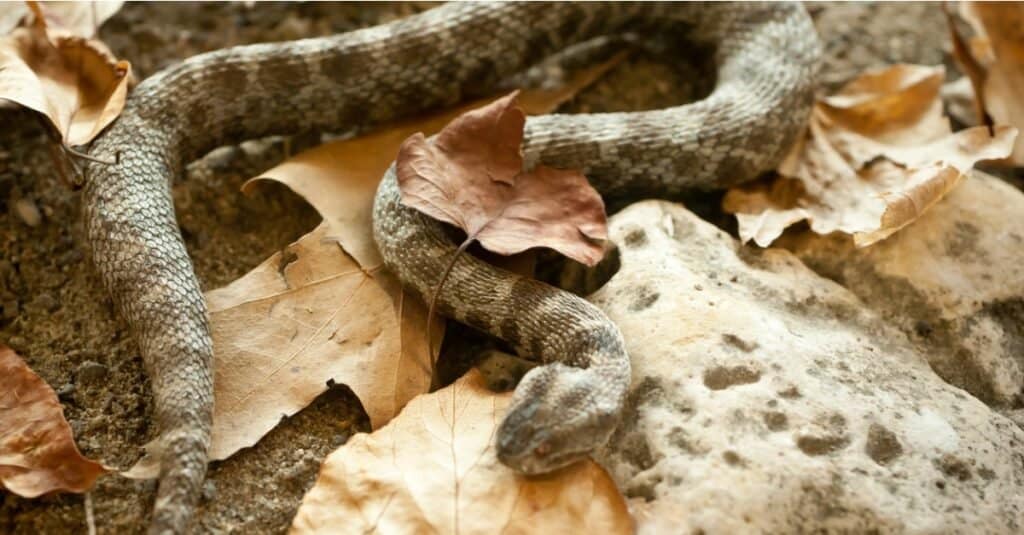
Massasaugas are small snakes with thick bodies, heart-shaped heads, and vertical pupils.
©iStock.com/Westhoff
Eastern massasauga rattlesnakes prefer habitats with open, sunny spaces as well as shady hiding places, near a water source. During the winter these snakes brumate in small mammal or crayfish burrows, rock crevices, basements, barn floors and tree roots. Eastern massasaugas return to the same hibernation sites each year. In fact, studies have shown that relocating these snakes outside of their natural range is detrimental because they cannot locate a suitable place for hibernation. Eastern massasauga rattlesnakes that are moved out of their home range only have a 50% survival rate.
The warmer spring weather of March and April signals the emergence of eastern massasauga rattlesnake from their long winter brumation. These snakes are active from April until late October, spending much of their time curled up near roads or on dikes, embankments, beaver lodges and grassy areas, where they enjoy basking in the warmth of the sun. Eastern massasaugas give birth to live young between August and September. A single female will give birth to 5-20 babies that are 7-10 inches in length.
Appearance
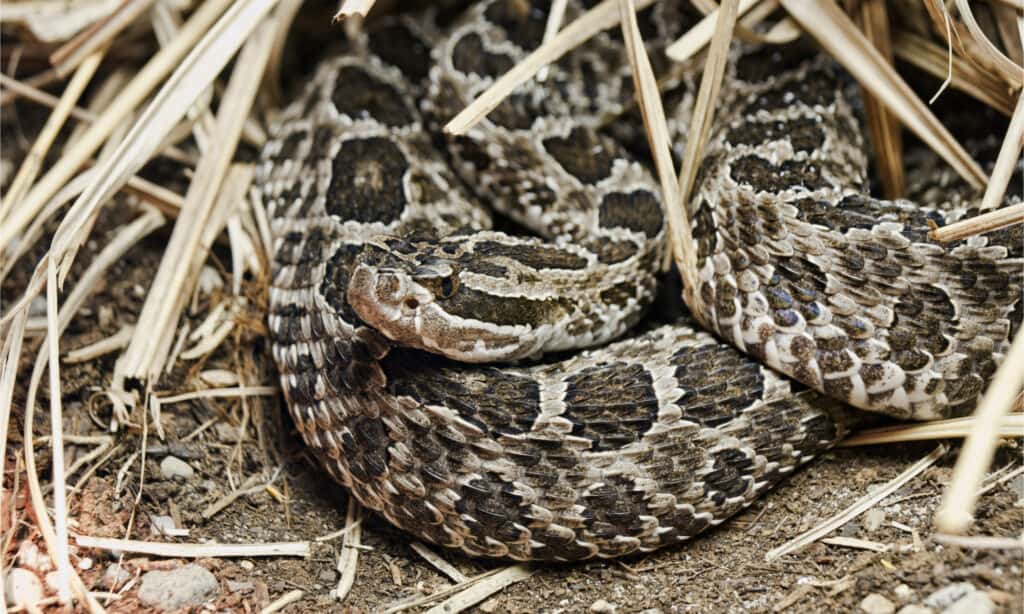
The eastern massasauga’s greatest weapon is its “cryptic” camouflage that allows the snake to hide in plain sight.
©DnDavis/Shutterstock.com
The eastern massasauga rattlesnake is a pit viper. This snake has heat-sensing “pits” on the front of its face, between its nostrils and eyes. These pit organs allow rattlesnakes to detect heat and infrared light, constructing a visual three-dimensional map of the surrounding environment and nearby animals. Eastern massasaugas also have larger heads with cat-like pupils, and a distinct, segmented rattle. Their rattles are smaller than other rattlesnakes, and make a much subtler buzzing sound. Although this rattle is the easiest way to identify a rattlesnake, baby rattlesnakes are born with only 1 rattle segment or keratin button. In addition, rattles can break off multiple times throughout a snake’s life and are slowly rebuilt over time. Be careful even if you cannot see a rattle on the end of a snake’s tail, just in case.
The eastern massasauga is a small rattlesnake, averaging between 24-30 inches in length. Many snakes are even smaller, often closer to 18 inches long. These snakes have heavy bodies covered in keeled or ridged scales. Their base color ranges from grey to greyish brown, with dark blotches edged with white running down the middle of their backs. There also smaller dark spots along the sides of their bodies, and their bellies are black with irregular bars. The colors and patterns of the eastern massasauga rattlesnake provide excellent camouflage, particularly when it is hiding in rocky areas or in leaf litter.
Behavior
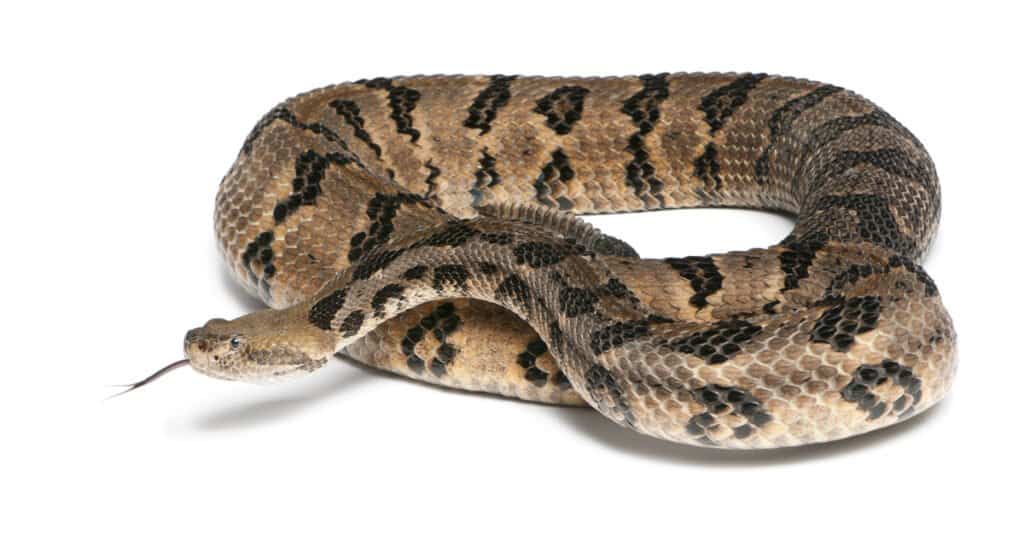
Eastern massasauga rattlesnakes can strike quickly, but only if the threat is close.
©fivespots/Shutterstock.com
In addition to their exceptionally “cryptic” camouflage, eastern massasauga rattlesnakes are shy and timid. These snakes do not always rattle their tails, even when a potential threat is near. Instead, they prefer to avoid detection by remaining motionless and hiding under debris. Even if you are close to an eastern massasauga rattlesnake, it is very likely that you will never see or hear it. If an eastern massasauga rattlesnake feels threatened or unsafe, it will attempt to quietly move to a new hiding place. However, if the snake is disturbed or harassed, it will rattle its tail in warning. The sound of an eastern massasauga is unique because it has such a small tail and rattle. Many people say that its rattle sounds more like a loud and angry bumblebee or large grasshopper.
Eastern massasauga rattlesnakes have strong hemotoxic venom that attacks red blood cells and circulation. This snake’s venom is lethal to the small prey it typically hunts, like shrews, voles, mice, and centipedes. However, eastern massasauga rattlesnakes have small fangs and cannot inject large amounts of venom. A bite from an eastern massasauga will be extremely painful, but it can easily be treated by a medical professional. In addition, these snakes very rarely bite, since they are so shy and secretive. Most bites that have occurred in Michigan were because someone harassed a snake or tried to catch it. Some people have been bitten by eastern massasauga rattlesnakes while walking through grassy wetlands areas, because they accidently stepped on a snake.
What To Do If You Encounter an Eastern Massasauga Rattlesnake

Massasaugas have colors and markings that include tan, gray, or brown with dark brown or black splotches.
©Rusty Dodson/Shutterstock.com
When walking through tall grass and wetlands areas, be sure to wear protective footwear, and be careful where you place your feet. Always keep your pets on leashes and do not let them sniff under logs, rocks, and in leafy piles of debris. If you see an eastern massasauga rattlesnake, leave it alone. It will return the favor and leave you alone as well. However, if you are concerned about the location of a snake, you can call Michigan Wildlife Department and they will safely relocate the snake to a suitable area.
The eastern massasauga rattlesnake is protected under the Endangered Species Act as a Threatened Species. In addition, this snake is a ‘Species of Special Concern’ in Michigan and is protected by state laws. Although massasaugas have the potential to be dangerous, these small rattlesnakes are not aggressive. Eastern massasauga rattlesnakes are important keystone species in the ecosystems of Michigan. Massasaugas help to keep insect and rodent populations in check, and they provide food for many of Michigan’s other animals.
Eastern Massasauga Rattlesnake Look-a-Likes: Michigan’s Nonvenomous
Due to its small size and extremely secretive nature, the eastern massasauga rattlesnake is very rarely encountered by humans in Michigan. However, there are a few nonvenomous snakes in Michigan that look a lot like the eastern massasauga rattlesnake. Even though they may look similar to a massasauga, these snakes are not dangerous. Let’s look at a few of the nonvenomous snakes in Michigan.
Eastern Fox Snake
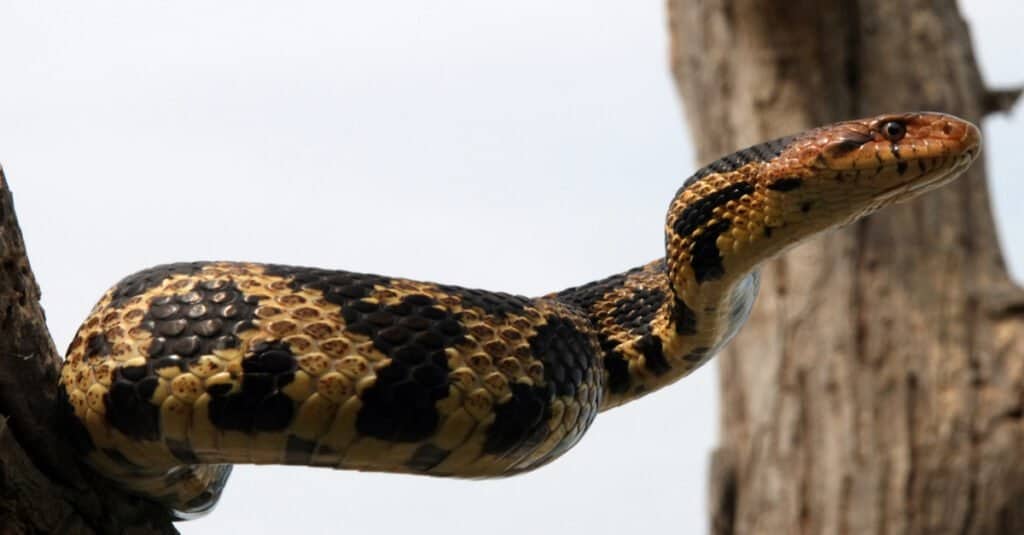
Eastern fox snakes are agile climbers but tend to stay closer to the ground.
©Ryan M. Bolton/Shutterstock.com
| Eastern Fox Snake | |
|---|---|
| Range | Southeastern Regions of Michigan’s Lower Peninsula |
| Length | 36-54 inches |
The eastern fox snake lives in the southeastern regions of Michigan’s Lower Peninsula. Like the massasauga rattlesnake, this snake prefers mashes, partially drained areas, woodland, and rocky habitats. Eastern fox snakes typically grow between 36-54 inches in length with yellow or light brown bodies. They have dark, bold patches along their backs, and smaller blotches along their sides. Their heads also have a brown, yellow or red hue. The eastern fox snake is commonly mistaken for a dangerous rattlesnake because of its appearance. It also tends to coil up and shake its tail to mimic a rattlesnake when it feels threatened. However, eastern fox snakes are harmless to humans. In fact, because of their beautiful colors and patterns, these snakes are even popular as pets. The eastern fox snake is a ‘Threatened Species’ in Michigan.
Western Fox Snake
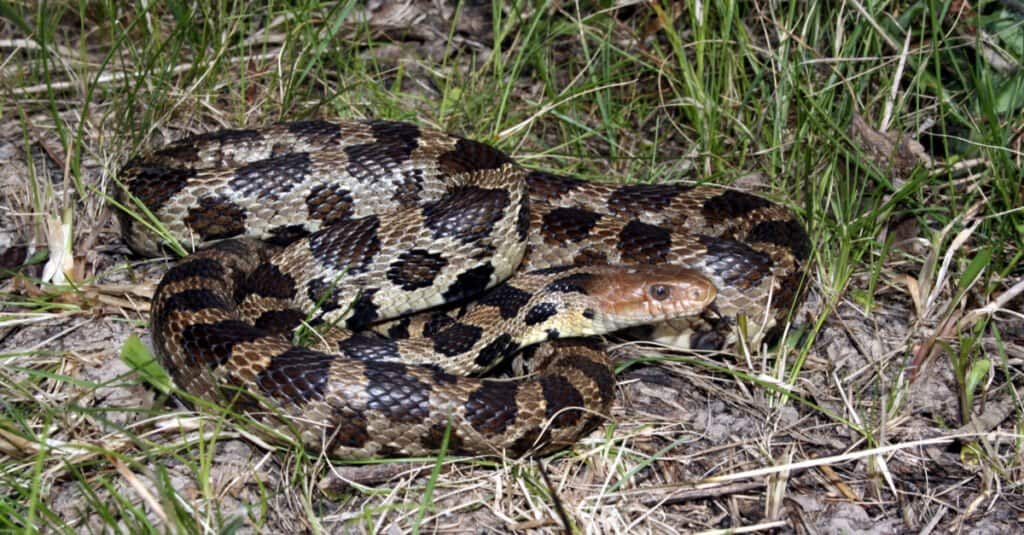
The only real difference between the two fox snake species is that the western tends to have more grey in the base color.
©Psychotic Nature/Shutterstock.com
| Western Fox Snake | |
|---|---|
| Range | Upper Peninsula in Michigan |
| Length | 36-54 inches |
The western fox snake lives in the Upper Peninsula of Michigan. These snakes look nearly identical to their eastern cousins, with light brown or tan bodies and large dark spots or blotches. Western fox snakes grow between 36-54 inches and have an orangish or reddish colored head. Because of its appearance, many people often mistake the western fox snake for a rattlesnake and kill it out of fear. However, these snakes are completely harmless and are beneficial in Michigan. In addition, the western fox snake is a ‘Species of Special Concern’ in Michigan because it has suffered from habitat loss and fragmentation.
Eastern Hognose Snake
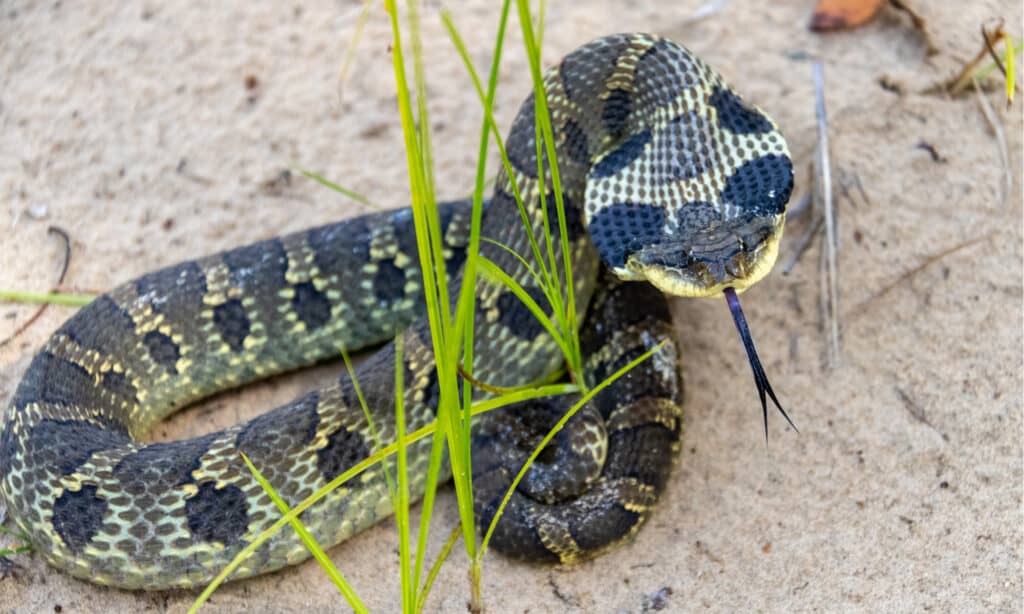
Eastern hognose snake with flattened neck on sandy soil with grass. Some snakes have rectangular spots down the middle of the back that may resemble eyespots.
©IHX/Shutterstock.com
| Eastern Hognose Snake | |
|---|---|
| Range | Michigan’s Lower Peninsula & Southern Tip of Upper Peninsula |
| Length | 20-40 inches |
The eastern hognose snake lives in the Lower Peninsula of Michigan, and the southern edge of the Upper Peninsula. This snake prefers habitats with sandy soil, and commonly lives in coastal habitats, woodlands, fields, and farmland. Hognose snakes have a uniquely upturned snout that they use to dig through sandy soil. These snakes are found in a wide variety of colors. Some snakes have large blotches or checkered patterns, while others are solid in color. When it feels threatened, an eastern hognose snake will flatten its neck like a cobra, hissing and striking. Because of this, many people call it a “puff adder”. Eastern hognose snakes also flip over and dramatically play dead until the threat is gone. Although they are often mistaken for a rattlesnake, eastern hognose snakes are not dangerous. However, they do have a very mild venom that can cause swelling and pain.
Up Next…
Interested in similar articles? Click the links below:
- The 10 Most Snake-Infested Lakes in the United States: What lakes host these slithering reptiles in record numbers? Find out which lakes are best avoided by swimmers in search of a refreshing splash.
- The Most Snake-Infested Lakes in Florida: It boasts an incredibly diverse ecosystem with almost 300 endemic species and loads of snakes too. Find out which of its lakes are a firm favorite for these reptiles which love warm weather.
- The 10 Most Snake-Infested Areas in the US: The United States is home to a large number of snake species. However, some states have more than others. Find out what they are and what areas have the most sightings.
The photo featured at the top of this post is © DnDavis/Shutterstock.com
Discover the "Monster" Snake 5X Bigger than an Anaconda
Every day A-Z Animals sends out some of the most incredible facts in the world from our free newsletter. Want to discover the 10 most beautiful snakes in the world, a "snake island" where you're never more than 3 feet from danger, or a "monster" snake 5X larger than an anaconda? Then sign up right now and you'll start receiving our daily newsletter absolutely free.
Thank you for reading! Have some feedback for us? Contact the AZ Animals editorial team.







